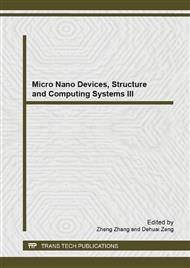[1]
Yier Jin, N. Kupp, Y. Makris, DFTT: Design for Trojan Test, Proc. of 17th IEEE International Conference on Electronics, Circuits, and Systems (ICECS), pp.1168-1171, (2010).
DOI: 10.1109/icecs.2010.5724725
Google Scholar
[2]
H. Salmani, M. Tehranipoor, J. Plusquellic, New design strategy for improving hardware Trojan detection and reducing Trojan activation time, Proc. of IEEE International Workshop on Hardware-Oriented Security and Trust(HOST), pp.66-73, (2009).
DOI: 10.1109/hst.2009.5224968
Google Scholar
[3]
R. Rad, J. Plusquellic, M. Tehranipoor, A Sensitivity Analysis of Power Signal Methods for Detecting Hardware Trojans Under Real Process and Environmental Conditions, IEEE Transactions on Very Large Scale Integration (VLSI) Systems, vol. 18, no. 12, pp.1735-1744, (2010).
DOI: 10.1109/tvlsi.2009.2029117
Google Scholar
[4]
M. Tehranipoor, F. Koushanfar, A Survey of Hardware Trojan Taxonomy and Detection, IEEE Design & Test of Computers, vol. 27, no. 1, p.10. 25, (2010).
DOI: 10.1109/mdt.2010.7
Google Scholar
[5]
R.S. Chakraborty, S. Bhunia, Security against hardware Trojan through a novel application of design obfuscation, IEEE/ACM International Conference on Computer-Aided Design (ICCAD) - Digest of Technical Papers, pp.113-116, (2009).
DOI: 10.1145/1687399.1687424
Google Scholar
[10]
Information on http: /www. weld. labs. gov. cn.
Google Scholar
[6]
S. Narasimhan, Xinmu Wang, Dongdong Du, R.S. Chakraborty, S. Bhunia, TeSR: A robust Temporal Self-Referencing approach for Hardware Trojan detection, Proc. of IEEE.
DOI: 10.1109/hst.2011.5954999
Google Scholar
[7]
Min Li, A. Davoodi, M. Tehranipoor, A sensor-assisted self-authentication framework for hardware trojan detection, Proc. of Design, Automation & Test in Europe Conference & Exhibition (DATE 12), pp.1331-1336, (2012).
DOI: 10.1109/date.2012.6176698
Google Scholar
[8]
M. Yoshikawa, et al. A Hardware Trojan for Cryptographic Countermeasure Circuits, Proc. of IMECS 2013, pp.680-684, (2013).
Google Scholar
[9]
M. Yoshikawa, et al. Trojan circuit for countermeasures against fault analysis attacks, Proc. of Waset, No. 74, pp.62-66, (2013).
Google Scholar
[10]
Z. Wang, M. Karpovsky, A. Joshi, Secure Multipliers Resilient to Strong Fault-Injection Attacks Using Multilinear Arithmetic Codes, IEEE Trans. on Very Large Scale Integration (VLSI) Systems, pp.1-13, (2011).
DOI: 10.1109/tvlsi.2011.2147340
Google Scholar
[11]
S.S. Ali, D. Mukhopadhyay, A Differential Fault Analysis on AES Key Schedule Using Single Fault, Proc. of 2011 Workshop on Fault Diagnosis and Tolerance in Cryptography (FDTC), pp.35-42, (2011).
DOI: 10.1109/fdtc.2011.10
Google Scholar
[12]
RCIS, Standard Cryptographic LSI Specification with Side Channel Attack Counter Measures, AIST, pp.85-89, (2010).
Google Scholar


